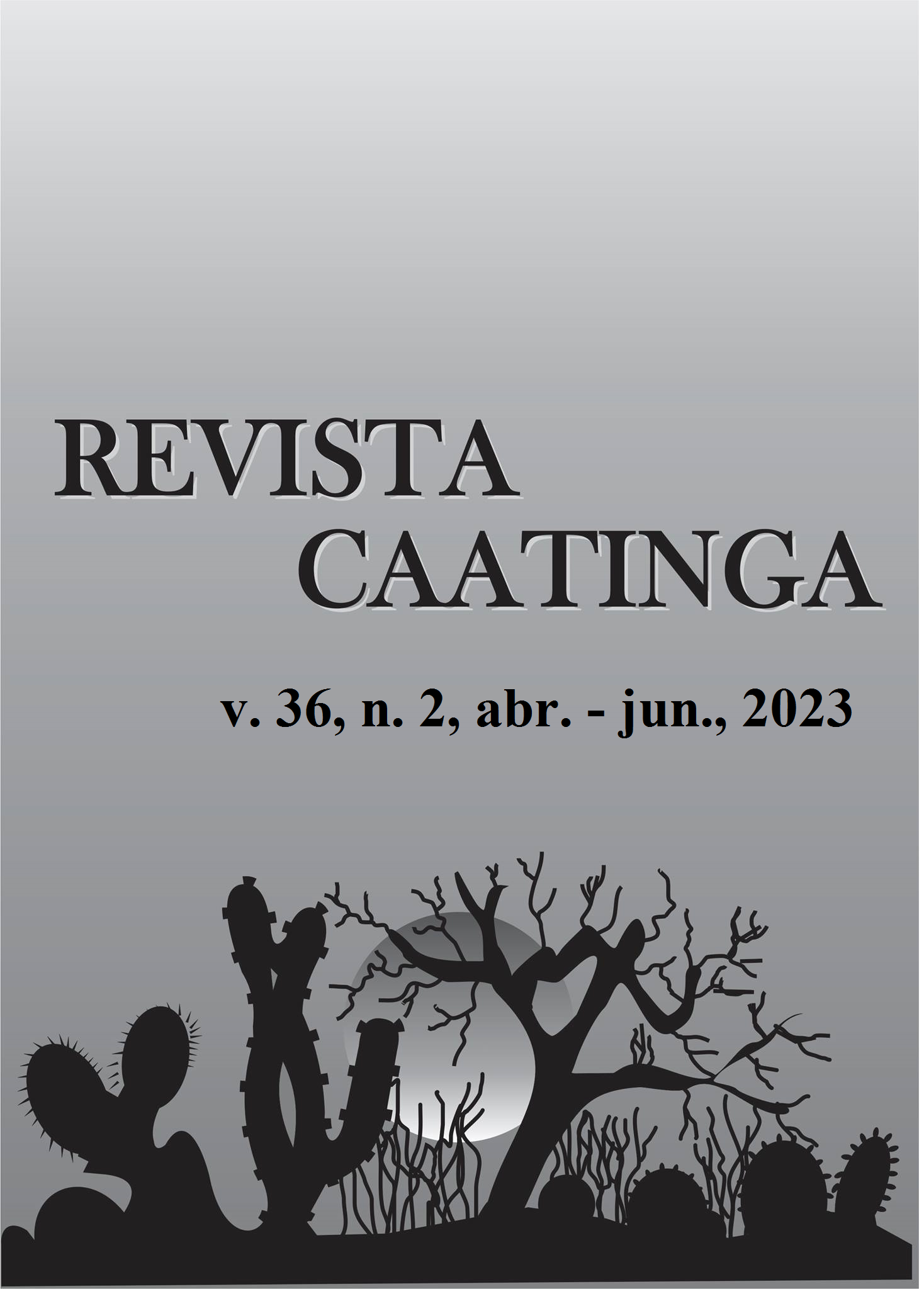Cover crops and biocontrol agents in the management of nematodes in soybean crop
DOI:
https://doi.org/10.1590/1983-21252023v36n201rcKeywords:
Meloidogyne incognita. Pratylenchus brachyurus. Biological control.Abstract
In the Brazilian Cerrado, phytonematodes, phytonematodes are a challenge for agriculture, and the association of forms of control is the best strategy to be used in coexistence with this pathogen. Faced with this problem, this study aimed to evaluate the efficiency of cover crops and biocontrol agents in the management of nematodes in soybean. For each nematode species under study (Meloidogyne incognita and Pratylenchus brachyurus), two experiments were carried out under greenhouse conditions in a completely randomized design arranged in a 6 x 2 factorial scheme with eight replications. Six cover crops (millet ADRG 9050, millet ADR 300, Urochloa ruziziensis, Crotalaria ochroleuca, C. spectabilis, and corn hybrid DKB 290) and two treatments (treated or not with Bacillus subtilis and B. methylotrophicus - 1x106 CFU per seed) were evaluated. The cover crops were sown in soil infested with nematodes and then soybeans were sown under the straw, and cultivated for 45 and 60 days, for M. incognita and P. brachyurus, respectively. Fresh root mass, total nematode population, and the number of nematodes per gram of root were evaluated. The association of microorganisms with C. spectabilis, U. ruziziensis, and millet ADR 300 conferred an additional effect in reducing the population of P. brachyurus. For M. incognita, the association was successful only for combining C. spectabilis with B. methylotrophicus. DKB 290 corn, when treated with B. methylotrophicus, had the nematode population per gram of soybean root reduced by 90% compared to plants that did not receive biological treatment.
Downloads
References
ALCANFOR, D. C. et al. Controle de nematóides de galhas com produtos naturais. Horticultura Brasileira, 19: Suplemento - CD ROM, 2001.
ARIEIRA, C. R. D. Bacillus: importante aliado no controle biológico de nematoides. 2020. Disponível em: https://ilustrado.com.br/bacillus-importante-aliado-no-controle-biologico-de-nematoides. Acesso em: 20 out. 2022.
BASYONY, A. G.; ABO-ZAID, G. A. Biocontrol of the root-knot nematode, Meloidogyne incognita, using an eco-friendly formulation from Bacillus subtilis, lab. and greenhouse studies. Egyptian Journal Biological Pest Control, 28: 1-13, 2018.
BONETI, J. I. S.; FERRAZ, S. Modificação do método de Hussey e Barker para extração de ovos de Meloidogyne exigua de raízes de cafeeiro. Fitopatologia Brasileira, 6: 553-553, 1981.
CRUZ, T. T.; ASMUS, G. L.; GARCIA, R. A. Espécies de Crotalaria em sucessão à soja para o manejo de Pratylenchus brachyurus. Ciencia Rural, 50: 1-8, 2020.
COOLEN, W. A.; D’HERDE, C. J. A method for the quantitative extraction of nematodes from plant tissue. Ghent: State Nematology and Entomology Reserch Station, 1972, 77 p.
COSTA, M. J. N.; PASQUALLI, R. M.; PREVEDELLO, R. Effect of soil organic matter content, cover crop and planting system on the control of Pratylenchus brachyurus in soybean. Summa phytopathol, 40: 63-70, 2014.
DIAS, W. P. et al. Nematoides em Soja: Identificação e Controle. Londrina, PR: Embrapa Soja, 2010. 8 p. (Circular Técnica 76).
FRANCHINI, J. C. et al. Perda de produtividade da soja em área infestada por nematoide das lesões radiculares na região médio norte do Mato Grosso. In: BERNARDI, A. C. C. et al. (Eds.). Agricultura de precisão: resultados de um novo olhar. Brasília, DF: Embrapa, 2014. v. 1. , cap. 24, p. 274-278.
GOULART, A. M. C. Aspectos Gerais Sobre Nematoides-das-lesões-radiculares (Gênero Pratylenchus). 1 ed., Planaltina, DF: Embrapa Cerrados, 2008. 27 p.
HUSSEY, R. S.; BARKER, K. R. A comparison of methods of collecting inocula of Meloidogyne spp., including a new technique. Plant Disease Reporter, 57: 1025-1028, 1973.
JOHNSON, A. W. Specific crop rotation practices combined with cultural practices and nematcides. An Advanced Treatise on Meloidogyne. v. 1. Biology and control, 1: 283–301, 1985.
OLIVEIRA, K. C. L. et al. Biological management of Pratylenchus brachyurus in soybean crops. Revista Caatinga, 32: 41-51, 2019.
SILVA, R. A. et al. Reação de cultivares de Brachiaria spp. a Pratylenchus brachyurus. Revista Connection Line, 9: 122–129, 2013.
SILVA, R. A. Manejo integrado de fitonematoides em soja e algodão. Revista Cultivar: Programas de aplicações, 201: 45-50, 2016.
SILVA, R. A. et al. Efeito da Rotação de culturas no manejo de nematoides em áreas arenosa. Nematropica, 48: 198-206, 2018.
WANG, K. H.; SIPES, B. S.; SCHMITT, D. P. Crotalaria as a cover crop for nematode management: a review. Department of Plant and Environmental Protection Sciences University of Hawaii, Honolulu, U.S.A. Nematropica, 32: 35-57, 2002.
Downloads
Published
Issue
Section
License
Os Autores que publicam na Revista Caatinga concordam com os seguintes termos:
a) Os Autores mantêm os direitos autorais e concedem à revista o direito de primeira publicação, com o trabalho simultaneamente licenciado sob a Licença Creative Commons do tipo atribuição CC-BY, para todo o conteúdo do periódico, exceto onde estiver identificado, que permite o compartilhamento do trabalho com reconhecimento da autoria e publicação inicial nesta revista, sem fins comerciais.
b) Os Autores têm autorização para distribuição não-exclusiva da versão do trabalho publicada nesta revista (ex.: publicar em repositório institucional ou como capítulo de livro), com reconhecimento de autoria e publicação inicial nesta revista.
c) Os Autores têm permissão e são estimulados a publicar e distribuir seu trabalho online (ex.: em repositórios institucionais ou na sua página pessoal) a qualquer ponto antes ou durante o processo editorial, já que isso pode gerar alterações produtivas, bem como aumentar o impacto e a citação do trabalho publicado (Veja O Efeito do Acesso Livre).







